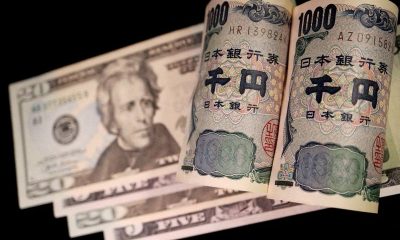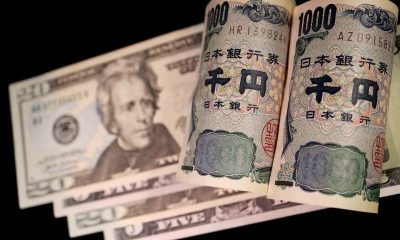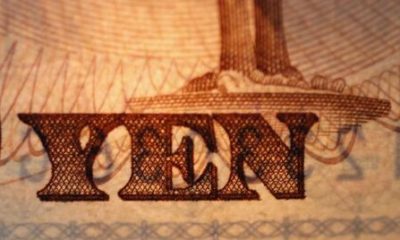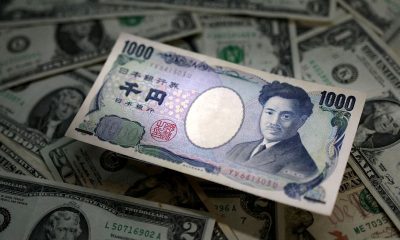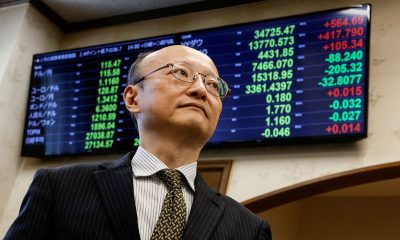Forex
Analysis-Dollar’s rally supercharged by diverging US rate outlook
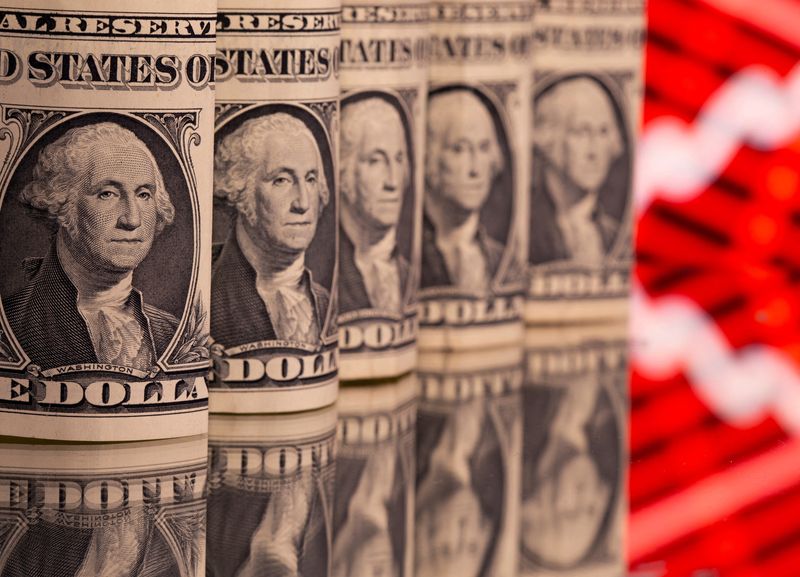
By Saqib Iqbal Ahmed and Laura Matthews
(Reuters) – A rally in the U.S. dollar is accelerating, as stubborn inflation sows doubts over how aggressively the Federal Reserve will be able to cut rates this year compared to other central banks.
The , which measures the greenback against a basket of six major currencies, is up 4.6% this year and stands near its highest levels since early November. The index rose 1.7% last week, its biggest weekly gain since September 2022.
The greenback is advancing as market participants grow convinced the Fed will need to leave interest rates at current levels for longer to avoid a potential resurgence of inflation. Last week’s stronger-than-expected consumer price data bolstered that view: investors late Friday were pricing in just 50 basis points of interest rate cuts in 2024, futures markets showed, compared to 150 basis points priced in at the start of the year.
By contrast, investors believe some global central banks – including the European Central Bank, the Bank of Canada and Sweden’s Riksbank – could have a freer hand to ease monetary policy. That is a shift from a few months ago, when many believed the Fed would be among the first to cut rates.
“We had a fairly clear path that the Fed would likely be the first actor. The data that we have received really does undermine that,” said Eric Leve, chief investment officer at wealth and investment management firm Bailard. “I can see obvious reasons why the dollar could strengthen further.”
Yield differentials between the U.S. and other economies have widened in recent weeks, contributing to the greenback’s rally as higher yields boost the allure of dollar-denominated assets. The two-year U.S.-German bond spread stood at its widest since 2022 late Friday, LSEG data showed, a day after the European Central Bank signaled it could cut rates as soon as June.
Bullish investors have increased their bets on the dollar, while bears have wavered. Net bets on the dollar in futures markets stood at $17.74 billion in the latest week, data from the Commodity Futures Trading Commission showed, the highest level since August 2022.
Central bank policy has diverged in recent months, reflecting economies’ varying struggles to contain inflation.
The Swiss National Bank reduced rates by 25 bps in March, its first cut in nine years. Sweden’s central bank has signaled it could cut rates in May if inflation keeps falling, while the Bank of Canada recently suggested it was ready to ease.
Central banks in Australia, Britain and Norway, on the other hand, appear less eager to loosen monetary policy.
Japan’s yen, meanwhile, has weakened to a near 34-year low against the dollar – though the country has recently ended eight years of negative interest rates. The Bank of Japan has ruled out using rate hikes to support the currency.
Eric Merlis, managing director and co-head of global markets at Citizens, believes the dollar could continue appreciating broadly on the back of a more hawkish Fed relative to the ECB. The euro has fallen 3.6% against the greenback this year.
“The dollar has room to strengthen. We have the strongest economy right now, in general, the trajectory of yields has been going up,” he said. “Whereas Europe is struggling in terms of growth.”
A stronger dollar could complicate the inflation fight for other economies as it pushes down their currencies, while helping the U.S. tamp down consumer prices by tightening financial conditions.
Dollar strength can also be a headwind for U.S. multinationals as it makes it more expensive to convert their foreign profits into dollars, and make exporters’ products less competitive abroad.
Other factors may also be driving the dollar. The U.S. currency is a popular destination for investors during times of geopolitical uncertainty, which has sharpened in recent days on fears over a widening conflict in the Middle East.
Brian Liebovich, chief dealer for global foreign exchange at Northern Trust (NASDAQ:), believes the dollar may receive a boost from the Fed allowing assets to run off its balance sheet, a process known as quantitative tightening.
The Fed is currently allowing up to $60 billion per month in Treasury bonds and up to $35 billion per month in mortgage bonds to mature and not be replaced.
While Northern Trust expected the dollar to strengthen by up to 5% going into the U.S. presidential election, “market activity since the initial dollar rally this week suggests that move could happen sooner than expected,” Liebovich said.
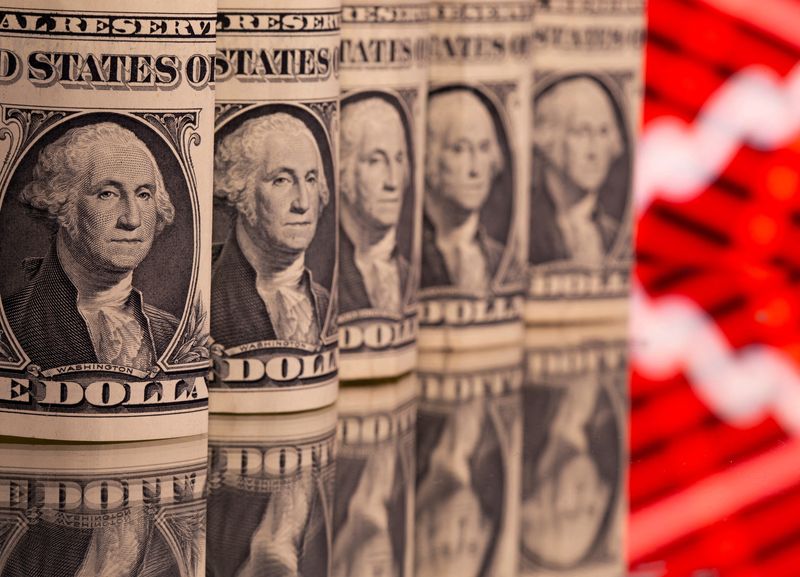
Others are less certain the dollar has more room to run. Shaun Osborne, of Scotiabank, wrote that the dollar’s recent strength means investors have priced in a good deal of bullish news.
Rates and spreads are in the dollar’s favor, however, meaning “the trend at the moment suggests the USD will stay better supported,” he said.
Forex
Yen falls after suspected intervention on Monday, eyes on Fed
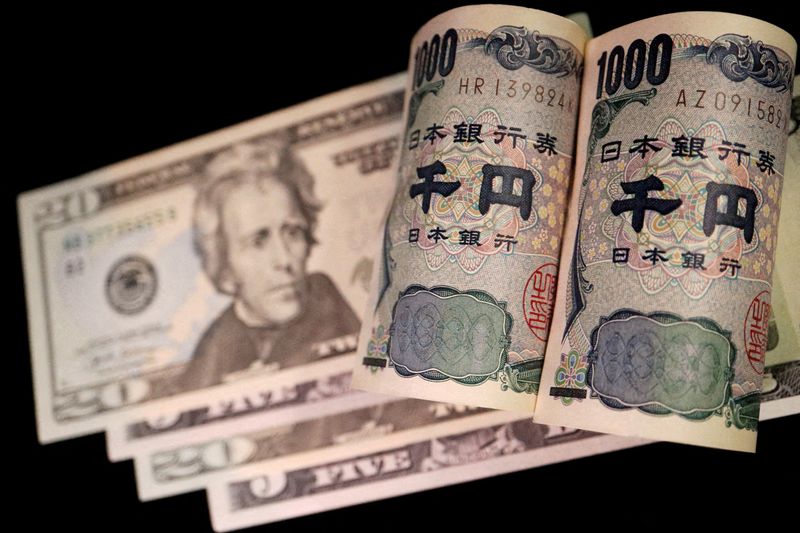
By Stefano Rebaudo
(Reuters) – The yen dropped against the dollar on Tuesday, giving up some of its sharp gains the previous day sparked by suspected intervention by Japanese authorities.
The currency was down 0.35% to 156.90 per dollar, but off its 34-year low of 160.245 hit on Monday when traders say yen-buying intervention by Tokyo drove a eye-catching rebound of nearly six yen.
It briefly dropped earlier in the session and stayed for a couple of minutes at 156.50, before recovering to 157.
Japanese officials may have spent some 5.5 trillion yen ($35.05 billion) supporting the currency on Monday, Bank of Japan data suggested on Tuesday.
“I think the BOJ will now wait for the dust to settle, but the 160 level remains the red line,” said Athanasios Vamvakidis, global head G10 forex strategy at BofA.
“Markets will test that level again, and if the Japanese authorities do not step in, the dollar can go much higher versus the yen,” he added.
The Bank of Japan (BOJ) on Tuesday left its plan for monthly bond buying unchanged for May. Japan’s government bond (JGB) investors are looking for clues on the timing of a taper, which will lead to higher, more attractive yields, supporting the yen.
“Facing that (the rates divergence between Japan and U.S.) with forex intervention typically does not end well,” said Garvey Padhraic, regional head of research Americas at ING.
“The more obvious solution to this is for Japanese rates to rise. If they don’t, something will have to give. And the bigger the hold-out, the bigger is the subsequent reaction,” he added.
remove ads
.
FOCUS ON FED POLICY MEETING
The Federal Reserve begins its two-day monetary policy meeting on Tuesday, where it’s expected to hold rates at 5.25%-5.5%, while striking a hawkish message.
“The Fed policy meeting could be a non-event for the euro/dollar as (Chair Jerome) Powell will not be as dovish as last time, but the market is already discounting such a backdrop by fully pricing just one rate cut in 2024,” Vamvakidis argued.
Traders have recently pared back bets of Fed rate cuts this year amid hotter-than-expected U.S. economic data and stubborn inflation numbers.
A rate cut in September was looking like a close call at just 44%, according to CME Group’s (NASDAQ:) FedWatch tool.
The dollar was down 0.02% to 105.67 against a basket of currencies ahead of the Fed’s meeting, after slipping 0.25% in the previous session.
“Fresh U.S. data has prompted our U.S. economist to push out his projection of the start of the Fed’s easing cycle to 2025 from December 2024,” said Thierry Wizman, global forex and rates strategist at Macquarie.
“We don’t rule out that the next change may be a hike, which would prompt a new wave of broad-based U.S. dollar strength.”
Other major central banks such as the European Central Bank (ECB) and the Bank of England (BoE) may begin to cut rates in the near future, even if the policy path is more uncertain after recent developments.
Euro zone inflation is on its way back to 2%, but the process is bound to be bumpy and geopolitical tensions pose an upside risk to price growth, ECB Vice President Luis de Guindos said late on Monday.
remove ads
.
Data showed that the bloc’s economy rebounded in the first quarter from a mild recession as Germany returned to growth and expansion accelerated elsewhere, while inflation steadied.
The euro fell 0.1% to $1.0731.
The offshore slipped 0.1% to $7.2477 per dollar and has depreciated 2% against the dollar so far this year, despite support from the central bank.
In cryptocurrencies, bitcoin fell 2% to $63,707.00.
($1 = 156.9400 yen)
Forex
Dollar gains ahead of Fed meeting; yen hands back some gains
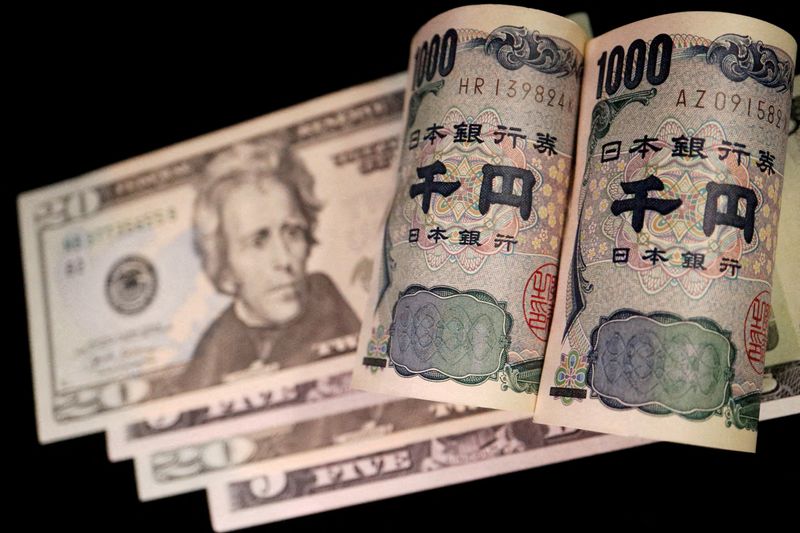
Investing.com – The U.S. dollar climbed higher Tuesday ahead of the start of the latest Federal Reserve policy-setting meeting, while the Japanese yen retreated after suspected intervention.
At 04:40 ET (08:40 GMT), the Dollar Index, which tracks the greenback against a basket of six other currencies, traded 0.3% higher at 105.780, on course for a gain of around 1.4% in April.
Fed meeting looms large
The dollar has generally been in demand this month as a series of hotter-than-expected U.S. inflation readings has resulted in traders pricing out early rate cuts by the .
The U.S. central bank starts its latest two-day meeting later in the session, and is widely expected to keep interest rates at the elevated 5.25%-5.5% levels when it concludes its gathering on Wednesday.
Investors will be awaiting indications about whether the Fed still expects to cut interest rates at some stage this year, having initially expected the first rate cut to come in March, then June and now in September.
Euro struggles despite German retail sales growth
In Europe, fell 0.2% to 1.0702, struggling to make ground against the strong dollar even after the release of data showing rose more than expected in March.
Retail sales increased by 1.8% compared to the previous month, pointing to a recovery in consumption which bodes well for the eurozone’s largest economy, which has just managed to avoid a recession.
Traders are awaiting the release of the latest inflation and growth data for the eurozone as a whole later in the session.
remove ads
.
Preliminary eurozone are expected to have risen 2.4% on the year in April, still marginally above the ECB’s 2.0% medium-term target, while the region is expected to have just 0.1% in the first quarter, growth of just 0.2% on an annual basis.
The has indicated that it is likely to cut its deposit rate in June, but there still exists a great degree of uncertainty over how many other cuts, if any, will be seen this year.
fell 0.2% to 1.2534, retreating in the wake of dollar strength, with sterling set to fall around 0.7% this month.
Yen retreats after suspected intervention
In Asia, rose 0.4% to 156.88, with the yen falling slightly against the dollar after the previous session’s sharp gains that looked like government intervention.
The pair is still way off the 34-year high of 160.245 seen in the previous session.
Japanese officials have refused to confirm intervention to support the yen, but the country’s top currency diplomat Masato Kanda said on Tuesday authorities were ready to deal with foreign exchange matters around the clock.
Mixed Japanese data factored into the yen’s weakness on Tuesday. While rose more than expected in March, missed expectations by a wide margin, presenting a muted outlook for consumer spending and inflation.
traded 0.1% higher to 7.2416 after mixed purchasing managers index data pointed to some slowing in the Chinese economy.
Official data showed activity slowing slightly less than expected, while grew substantially less than expected.
remove ads
.
fell 0.6% to 0.6527, with the Aussie dollar hit by the release of substantially weaker than expected data.
Forex
Asia FX weak as Fed jitters grow, yen stalls after suspected intervention
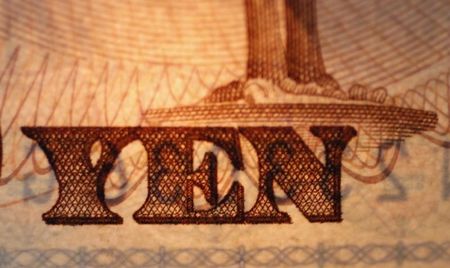
Investing.com– Most Asian currencies fell on Tuesday as anticipation of a Federal Reserve meeting this week kept traders largely biased towards the dollar, with the Japanese yen falling slightly after rebounding amid suspected government intervention.
Most regional currencies were nursing losses through April as traders steadily priced out expectations of early interest rate cuts by the Fed. A series of hotter-than-expected U.S. inflation readings drove this notion.
The and both rose about 0.3% in Asian trade, as investors positioned for the . The central bank is expected to keep rates steady, but could potentially offer hawkish signals in the wake of sticky inflation readings.
Fears of higher-for-longer U.S. rates put the dollar on course for a 1.3% gain in April.
Japanese yen softens, USDJPY rises after tumbling from 160
The pair, which gauges the amount of yen required to buy one dollar, rose 0.3% to about 156.80 on Tuesday.
The pair had fallen sharply from 34-year highs above 160 on Monday, sparking speculation that the Japanese government had intervened to buoy the yen. Traders said it appeared that the new line in the sand for the Japanese government was USDJPY at 160.
While the government gave no official word on the intervention, the yen rebound came after a series of verbal warnings from Japanese officials over the past month.
Mixed Japanese data factored into the yen’s weakness on Tuesday. While rose more than expected in March, missed expectations by a wide margin, presenting a muted outlook for consumer spending and inflation.
remove ads
.
The yen was the worst performer in Asia through April, with the USDJPY pair up nearly 4%.
Australian dollar sinks as weak retail sales dent rate outlook
The Australian dollar was the worst performer in Asian trade on Tuesday, with the pair sinking 0.5% after substantially weaker than expected data.
The reading showed that sticky inflation and high interest rates weighed heavily on consumer spending, which presented a softer outlook for inflation. Traders were seen slashing expectations that the Reserve Bank of Australia will hike interest rates further this year.
The Aussie was set for a muted performance in April.
Chinese yuan weakens on middling PMIs
The Chinese yuan’s pair rose 0.2% on Tuesday after mixed purchasing managers index data pointed to some slowing in the Chinese economy.
Official data showed activity slowing slightly less than expected, while grew substantially less that expected.
While a painted a rosier picture of manufacturing activity, the overall readings still showed limited strength in Chinese business activity.
The USDCNY pair was up 0.3% in April, with further gains constrained by persistent efforts from the People’s Bank.
Other Asian currencies weakened on Tuesday. The South Korean won’s pair rose 0.3%, while the Singapore dollar’s pair added 0.1%.
The Indian rupee’s pair edged closer towards record highs hit earlier in the month, as caution over the 2024 general elections gave the rupee little relief.

 Forex2 years ago
Forex2 years agoForex Today: the dollar is gaining strength amid gloomy sentiment at the start of the Fed’s week

 Forex2 years ago
Forex2 years agoHow is the Australian dollar doing today?

 Forex1 year ago
Forex1 year agoUnbiased review of Pocket Option broker

 Forex2 years ago
Forex2 years agoDollar to pound sterling exchange rate today: Pound plummeted to its lowest since 1985

 Cryptocurrency2 years ago
Cryptocurrency2 years agoWhat happened in the crypto market – current events today

 World2 years ago
World2 years agoWhy are modern video games an art form?

 Stock Markets2 years ago
Stock Markets2 years agoMorgan Stanley: bear market rally to continue

 Economy2 years ago
Economy2 years agoCrude oil tankers double in price due to EU anti-Russian sanctions

